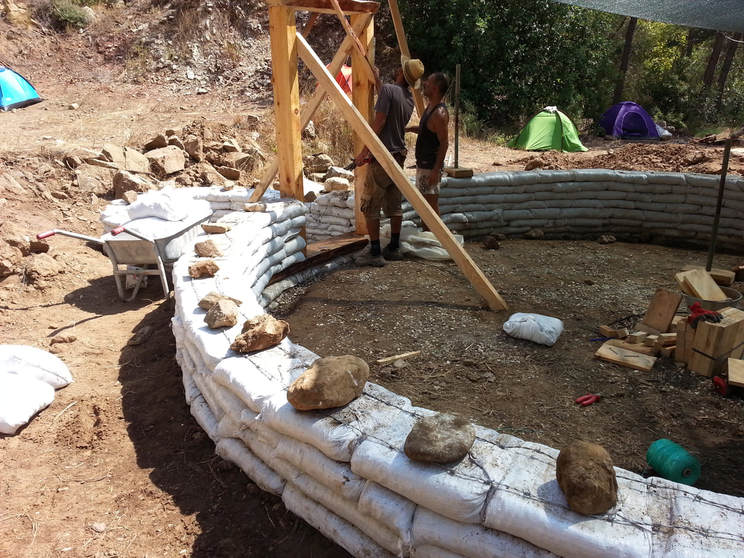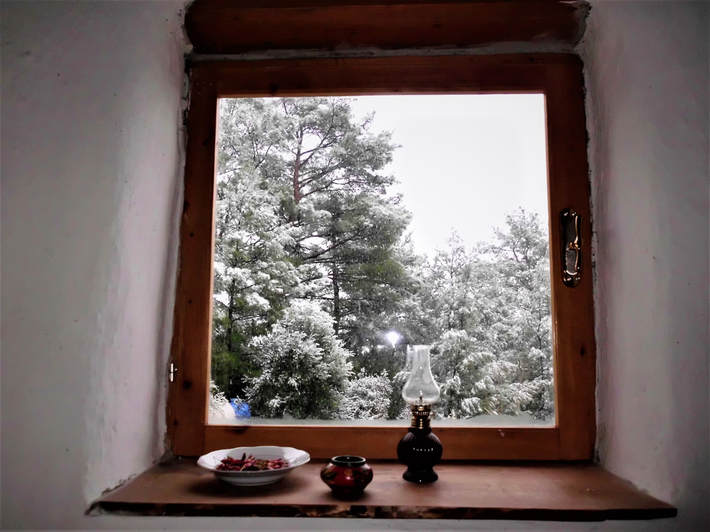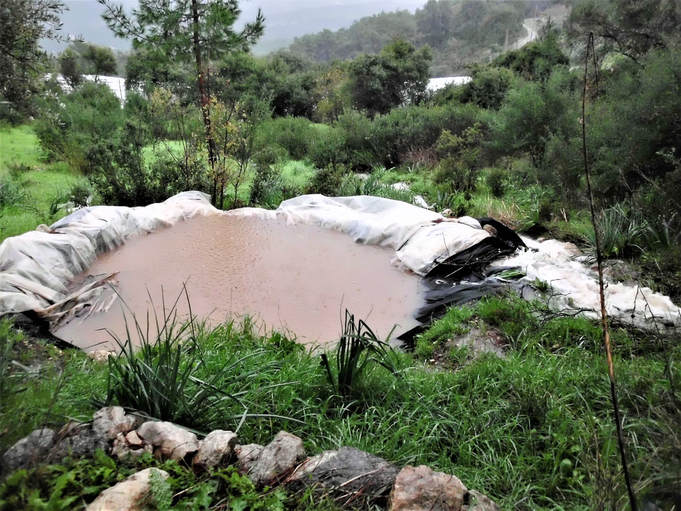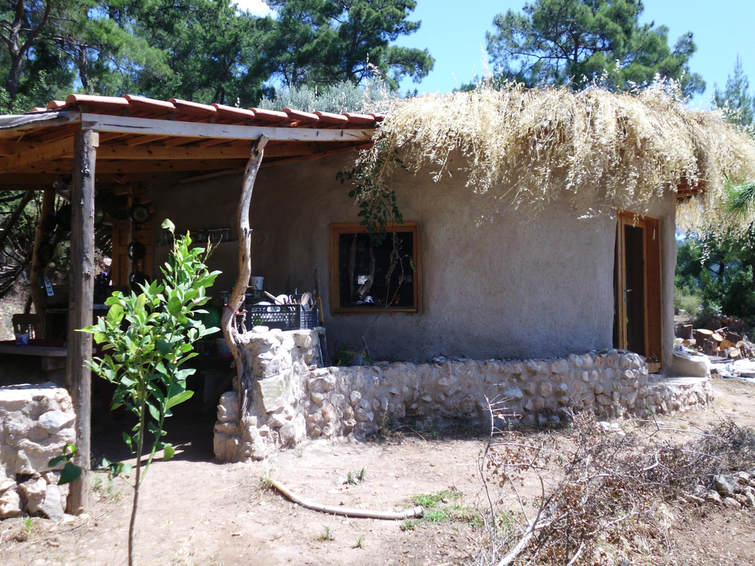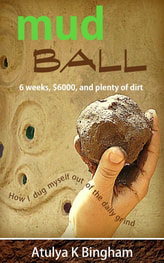How does Earthbag Cope with Extreme Weather?
Weather pummels a house. And many wonder: Can earthbag stand hurricanes, monsoons, or an ice age? Here's the full story on earthbag and all kinds of extreme weather.
The Wind
I think there's no other building technique more capable of standing high winds than earthbag. I sat through real humdingers of storms; hurricanes that uprooted trees and ripped water tanks from roofs. Inside my earthbag house, I hardly noticed there was anything happening...until I opened the door:)
The actual earthbag structure, if built correctly, is pretty invincible. I've heard of trees falling on them or trucks driving into them, with no obvious damage. How come? The layers of barbed wire form tensile rings that have both flexibility and strength, and this allows the building to shift without cracking or breaking. As with any structure you build,if you are facing gales, the issue is going to be the roof. In a climate with hurricanes, you need to choose your roof structure wisely and make sure the rafters are firmly anchored to the walls. You may want to add rope ties.
The Wind
I think there's no other building technique more capable of standing high winds than earthbag. I sat through real humdingers of storms; hurricanes that uprooted trees and ripped water tanks from roofs. Inside my earthbag house, I hardly noticed there was anything happening...until I opened the door:)
The actual earthbag structure, if built correctly, is pretty invincible. I've heard of trees falling on them or trucks driving into them, with no obvious damage. How come? The layers of barbed wire form tensile rings that have both flexibility and strength, and this allows the building to shift without cracking or breaking. As with any structure you build,if you are facing gales, the issue is going to be the roof. In a climate with hurricanes, you need to choose your roof structure wisely and make sure the rafters are firmly anchored to the walls. You may want to add rope ties.
The Cold
This is probably the toughest climate for an earthbag house. I've covered the ins and outs of insulation versus thermal mass and earthen homes in cold climates in this post. The bottom line is it's going to depend on exactly how cold your climate is. in a place where the temperature remains subzero for months on end, you're going to need a lot of insulation. Even so, earth is still better than Portland Cement. Really. The R value for earth is double that of concrete.
One thing you should be aware of is that earthbag shouldn’t be built in freezing temperatures. With super adobe, the mud goes in the bags wet so that it dries and hardens over time. If the bags were to freeze, instead of hard mud bricks you’d be left with sacks of powder. Yikes!
This is probably the toughest climate for an earthbag house. I've covered the ins and outs of insulation versus thermal mass and earthen homes in cold climates in this post. The bottom line is it's going to depend on exactly how cold your climate is. in a place where the temperature remains subzero for months on end, you're going to need a lot of insulation. Even so, earth is still better than Portland Cement. Really. The R value for earth is double that of concrete.
One thing you should be aware of is that earthbag shouldn’t be built in freezing temperatures. With super adobe, the mud goes in the bags wet so that it dries and hardens over time. If the bags were to freeze, instead of hard mud bricks you’d be left with sacks of powder. Yikes!
The Wet
Now, in the minds of most people there is a large, swampy question mark regarding earthbag and water. Will the plaster fall off? Will the walls wick up water? Will it turn into massive round chocolate blancmange and melt? In fact, one reason you might want to choose earthbag over a cob or adobe structure is flooding. The bags and the barbed wire keep the structure in place, even if the worst came to the worst and it flooded. But your earthbag home doesn’t need to flood in the first place. It’s all in the foundations, you see. If you haven’t heard me harping on about gravel foundations yet (where have you been?), well take a look at the gravel foundation page. This, in my opinion, is the make or break of earth homes and flooding. My house was basically sitting in a shallow lake at one point, and I had to wade through thick, saturated mud to get to my door. Yet inside it was dry as a bone. Gautam Singh's earthbag house with gravel foundations was just as successful through the monsoons of Mumbai.
Now, in the minds of most people there is a large, swampy question mark regarding earthbag and water. Will the plaster fall off? Will the walls wick up water? Will it turn into massive round chocolate blancmange and melt? In fact, one reason you might want to choose earthbag over a cob or adobe structure is flooding. The bags and the barbed wire keep the structure in place, even if the worst came to the worst and it flooded. But your earthbag home doesn’t need to flood in the first place. It’s all in the foundations, you see. If you haven’t heard me harping on about gravel foundations yet (where have you been?), well take a look at the gravel foundation page. This, in my opinion, is the make or break of earth homes and flooding. My house was basically sitting in a shallow lake at one point, and I had to wade through thick, saturated mud to get to my door. Yet inside it was dry as a bone. Gautam Singh's earthbag house with gravel foundations was just as successful through the monsoons of Mumbai.
The heat
My little mud home in Turkey had lot to deal with. Winters were prone to flooding and summers were furnace-like. The temperature could easily reach 45 degrees centigrade in the shade in July or August. My house wasn't under trees, so it was taking a full sun-bashing all summer. Did it care? Not a hoot. To be honest, earth homes are made for hot dry climates. Depending on your roof and how thick your walls are, they can retain the cool inside for many hours. Heat works its way through solid earthen walls about an inch or so an hour. These structures are perfect for the desert with hot days and cool nights, because the earth slowly absorbs the heat in the day and releases it back into the house at night. In the day it retains the cool.
My little mud home in Turkey had lot to deal with. Winters were prone to flooding and summers were furnace-like. The temperature could easily reach 45 degrees centigrade in the shade in July or August. My house wasn't under trees, so it was taking a full sun-bashing all summer. Did it care? Not a hoot. To be honest, earth homes are made for hot dry climates. Depending on your roof and how thick your walls are, they can retain the cool inside for many hours. Heat works its way through solid earthen walls about an inch or so an hour. These structures are perfect for the desert with hot days and cool nights, because the earth slowly absorbs the heat in the day and releases it back into the house at night. In the day it retains the cool.
The Mud Home remains free (and ad-free) and takes me many hours a month to research and write, and goes into the hundreds to run. If you find any joy, inspiration, and value in what I do, please consider becoming a Mud Patron. For less than the price of a coffee you can join my private news feed, ask me questions, and become part of our thriving mud club.
Many thanks to our Mud Sustainers and all those already supporting The Mud Home. It is thanks to you the site is still running.
Many thanks to our Mud Sustainers and all those already supporting The Mud Home. It is thanks to you the site is still running.

